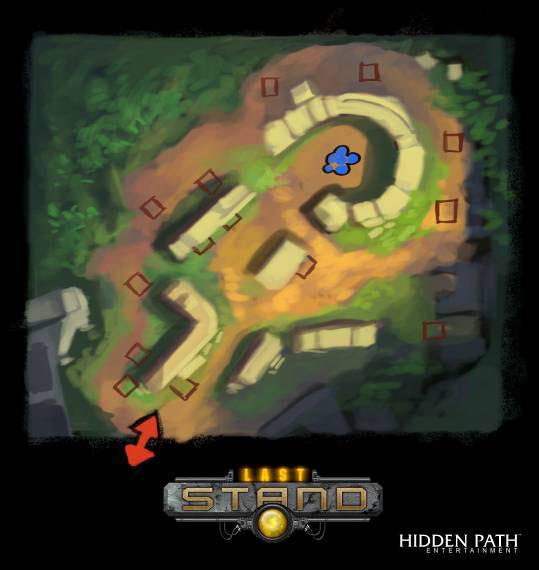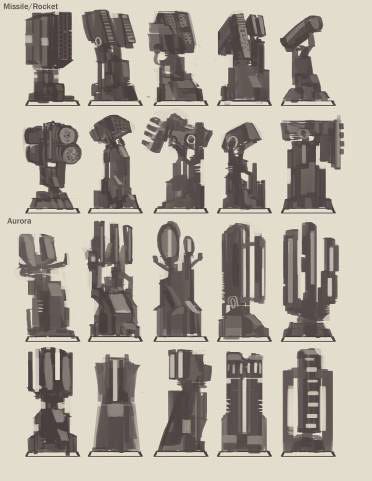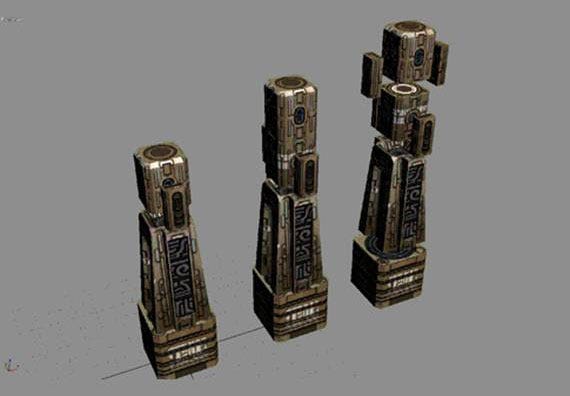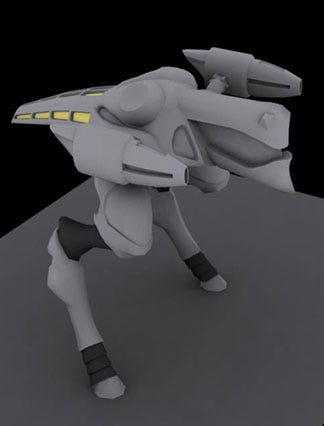Trending
Opinion: How will Project 2025 impact game developers?
The Heritage Foundation's manifesto for the possible next administration could do great harm to many, including large portions of the game development community.
The creators of Hidden Path's PC and upcoming XBLA title Defense Grid: The Awakening look at the visual concept work that went into the game's creation, suggesting that "pre-production concept development and visualization resulted in a much better looking game and in significantly reduced problems" during the title's development.

[In an in-depth article, the creators of Hidden Path's critically acclaimed PC and upcoming XBLA title Defense Grid: The Awakening look at the visual concept work that went into the game's creation, suggesting that "pre-production concept development and visualization resulted in a much better looking game and in significantly reduced problems" during the title's development.]
This article is about the evolution of the final look of Defense Grid: The Awakening and includes some of the concept art we developed to guide the creation of the game. It explores our approach to creating the look for a downloadable game with a limited schedule and budget while still maintaining the production values of a full-priced retail product.
In late 2007 Hidden Path started kicking around the idea of creating a unique new game based on the Tower Defense genre.
We particularly wanted to extend this style of gameplay in a way to appeal to those who were familiar with Tower Defense games.
But we also wanted make a compelling experience that could appeal to gamers who had never played that style of game.
(Incidentally, for those who haven't seen Defense Grid: The Awakening, the trailer provides a quick glimpse of the result.)

Defense Grid: The Awakening Screenshot
Unlike the great majority of Tower Defense games, many of which are flash-based with simple 2D graphics, our proposal was to create a game with advanced 3D environments and characters and high production values similar to what one might expect from a triple-A retail game.
We also wanted context and a storyline to draw players into the experience. Additionally we wanted to incorporate some of the gameplay and experiential lessons we had all learned in some of our past big-budget PC and console projects.
Creating downloadable games that play and feel more like retail games is something Hidden Path Entertainment had been contemplating for some time. Despite the challenges of fitting all this into a downloadable title, as the design began to take shape we all knew that Defense Grid was a game we had to make.
The original design document for Last Stand, which was the game's working title, described the action as occurring in a war-torn urban environment. Mindless bio-organic marauders launched wave after wave of attacks within ruined cityscapes as the player created defensive towers to repel the horde and defend the hapless inhabitants.


Sirio Brozzi
While the machine-organisms described in the original proposal were retained, we fairly quickly re-considered the setting and circumstances. Bleak, half-destroyed urban environments are a common setting for games (albeit many great ones), and we wanted to create something a little more distinctive.
After a while, the endless grey-brown dark destroyed city environments (no matter how artfully created) start to all look the same. Having previously created my own share of them at other game studios, I was eager to explore alternate ideas.
We liked the idea of setting the game in the distant future. It allowed us more freedom in creating environments and situations. We first imagined cities built from the ground up to defend against attack, and senior artist Mark Forrer created a number of paintings of urban settings which incorporated a martial appearance and defensive structures but avoided a dark apocalyptic feel.


Mark Forrer
Like many artists, when imagining the far future, the Defense Grid concept team looked to the past for possible inspiration.
The shapes of the monolithic structures of the Maya or Egyptians have an angular utilitarian design that is echoed in numerous science fiction environments.
Perhaps more importantly, ancient sites are magical wondrous places and their appearance conjures up thoughts of distant times and lives - future as readily as past.

To incorporate some of the emotional impact of ancient ruins into the game, we wove the idea into our backstory that many of the environments in Defense Grid would themselves be long abandoned places; relics of an earlier war against an ancient enemy that has returned to threaten mankind again.


John Thacker

Mark Forrer
To reinforce this idea of long abandoned sites, we explored giving our structures the rough blocky appearance of ancient stonework which we justified as heavy stone-like armor similar to hardened concrete military bunkers.


Mark Forrer
In addition to being evocative imagery, this blocky ancient appearance would help emphasize the difference between the player's defensive structures and the smooth bio-tech appearance of our attackers. Plus, it would give the game a unique look and help springboard the rest of the visual design process.
We did wind up departing from this style for a few of the levels seen towards the end of the game. If you have finished the storyline part of the game, you will likely recognize the levels these paintings inspired.


Mark Forrer
Initially the game's action happened close to the ground, with our abandoned bases composed of ancient military bunkers nestled into the terrain and the towers popping out from below the ground.


Mark Forrer
As we considered that Defense Grid would be a fully three-dimensional game -- unlike tower defense games of the past -- we began to think about how to exploit this 3D character.
The viewpoint of the player would be looking down onto the playfield, so we explored adding a lot of height differences and vertical elements to the environment to emphasize the third dimension.
We also decided to make the scale of the game more epic. Everything, from enemies to environments, would be large to emphasize the scale of the conflict. Buildings and terrain would be tall and dramatic. Rather than having the game's non-flying enemy travel along pathways on the ground, they would travel on elevated roadways which would connect the vertical structures.
This approach would dramatically enhance the sense of a three-dimensional space and also allow over and underpasses, introducing new "depth" to game play.

When we visualized this idea we saw that, not only did it enhance the game, but this elevated multi-layer visual approach would give Defense Grid a distinctive look. This was the approach we used to guide environment creation throughout the project.

(Click for full size)
With the fundamentals of our environments established, we began visualizing the towers themselves. The towers are the player's game pieces. They needed to look functional and represent the player's projection of power onto the field of battle.
We started with a handful more, but settled on 10 different fundamental tower types for the game. More than 10 started to get confusing. The differences between types blended together and players had to memorize too many factors in considering which tower to deploy to respond to the alien threat.
It was important that the appearance of each tower be distinctive and appropriate for the type of weapon mounted on it so that players would be able to quickly scan the field and determine what weapons systems were deployed where.
Since each tower type had three different strength levels, we also needed to visually represent three variations of each tower type.
The visual designs of the towers probably went through more fundamental and dramatic revisions than any other aspect of the game. We would start with basic concept sketches or paintings and then build 3D models of promising designs to see how they looked from multiple angles.


Like the rest of the game environment, the towers started out fairly close to the ground, but this seemed inconsistent with the rest of the highly vertical environment and created problems with towers having line of sight to their intended targets. We experimented with mounting our low-to-the-ground weapon designs onto generic pylons, but this made the weapons themselves small and hard to distinguish.
Knowing that we wanted the towers to be tall structures, we tried making the entire tower -- not just its weapon -- more unique for each tower type, with each design having a distinct silhouette. Concept artist Sirio Brozzi created numerous silhouette studies to explore this approach and then built 3D models of the chosen designs to help us understand how they would look from different viewpoints.




Sirio Brozzi
Around this time, Lex Story joined Hidden Path. Lex had done the industrial design on weapons and machinery for many notable games including the Mechwarrior and Mechcommander series, Crimson Skies, Shadowrun and Supreme Commander.
Lex took over tower design and brought a new approach to the effort, making the towers look more like functional military equipment. He also worked with Hidden Path's animation director, Adam Crocket, to determine ways the towers would animate as they deployed from the ground and fired.
Using the former designs as a starting point, Lex designed and modeled all 30 towers required for the game. A few of the tower types and their different upgrade levels are shown below. The mix of tech and ancient influences is particularly apparent in the command tower group shown first.




Lex Story
Unlike other aspects of the game, the idea for the look of the alien enemies never fundamentally changed. From the very beginning we wanted the aliens to be somewhat insectoid mixes of organism and machine. I knew the perfect guy to design and build these kinds of creatures. I had worked with Greg Onychuk years ago at FASA Interactive, and he had been creating designs like this for various projects for years. I hired Greg onto the project, and he instantly started turning out all manner of bizarre looking bad guys.

Greg Onychuk
Greg started by creating sketches like the one above, but was so quick at designing this kind of creature on the fly, that he started just building models without concept sketches. These were reviewed and revised to make the final game assets.



Greg Onychuk
As with the towers, we started with a larger number of aliens but winnowed their number down to 16. Since time was tight and Greg was busy building and texturing the alien models, Sirio Brozzi again lent his ability to rapidly brainstorm on visual ideas and created numerous designs for the flying and hovering aliens that appeared in the game, while Greg focused on the walkers.

Sirio Brozzi (Click for full size)
By the time the user interface and front-end design for Defense Grid started, we had established the idea that the game involved the re-activation of long abandoned defensive bases that had previously been used to defend mankind against the alien threat seen in the game. We determined that the user interface should have a functional military look, but also have some sense of being somewhat antiquated. Mark Forrer experimented with a range of styles, some of which incorporated heavy machinery-looking elements into the design.


Mark Forrer
In the end, we settled on a more electronic-looking interface. We still included some textural and overlay elements to evoke the look of an ancient device with elements briefly blurring or smearing or showing obvious scan-lines as they first appear on screen.
We also settled on a largely amber color scheme in homage to the early days of personal computing when amber monitors were all the rage.
Below are some of the concept pieces used in developing the final look of the UI.



Mark Forrer
The final major visual element we created was a character from the game's story we referred to as "The Entity."
The Entity is an AI character who inhabits the battle machine re-activated by the player to defend his homeworld from destruction. We wanted this character to be a kind of ghost in the machine and to include both human and mechanical qualities. Mark Forrer played around with a few concepts for this character's appearance within the system.


The final result was definitely mechanical, but seemed to also evoke a human face.

Mark Forrer
The sense of a living entity is quite a bit more effective and interesting when animated.
Creating a high-end looking game on a reduced budget and schedule may result in a smaller concept team than with a larger game, but all the steps required to create the look of the game are the same as for a big-budget title.
Particularly when creating a new franchise, concept and prototype work often represent a larger percentage of the budget for these titles than for larger projects.
Our experience with Defense Grid was that spending more time and money during pre-production concept development and visualization resulted in a much better looking game and in significantly reduced problems and expense during production.
Read more about:
FeaturesYou May Also Like